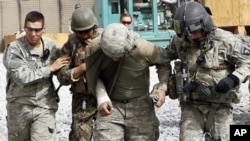Researchers are working to develop nanoparticles that could speed blood clotting and potentially save lives.
Blunt force trauma, stab wounds and gunshot wounds can all cause life-threatening internal bleeding.
And for soldiers in wartime, more and more are returning with internal bleeding linked to traumatic brain injuries, or TBIs, caused by roadside bombs, according to Erin Lavik, a researcher at the University of Maryland in Baltimore.
Surgery is the most common method used to stop hemorrhaging and prevent death.
"One of the things about hemorrhaging is you can bleed a lot and be fine,” Lavik said, “but then there's a tipping point where, if you bleed past a certain point, it's suddenly lethal."
A number of research teams are working to develop agents that can help speed blood clotting.
Lavik and his colleagues are using nanoparticles — microscopic particles that are part of a protein complex in the body — that act as bridges to platelets, which are blood fragments that rush to the site of an injury to stop bleeding.
The nanoparticles, which are delivered intravenously, stick to the platelets, activating them quickly so they join together to hasten the formation of clots.
After the bleeding has stopped, the particles clear the system.
The researchers tested the nanoparticles in rats. One test simulated bleeding from a blast shock that often causes injuries in hollow internal organs, such as the lungs.
A test on the liver, a blood-rich organ that can be ruptured by a blow to the abdomen, showed that nanoparticles look promising in stanching the bleeding.
The researchers are also looking at nanoparticles as a way to minimize bleeding in brain and spinal cord injuries, as well.
Lavik presented the work at the annual meeting of the American Chemical Society.
Human trials will be conducted to make sure the nanoparticles don't trigger a harmful immune response. Another concern is that the nanoparticles could worsen clotting in the legs or lungs, which can be deadly.
Lavik estimates it could take five to ten years for a nanoparticle treatment to be ready to administer in hospital emergency rooms or combat zones.








